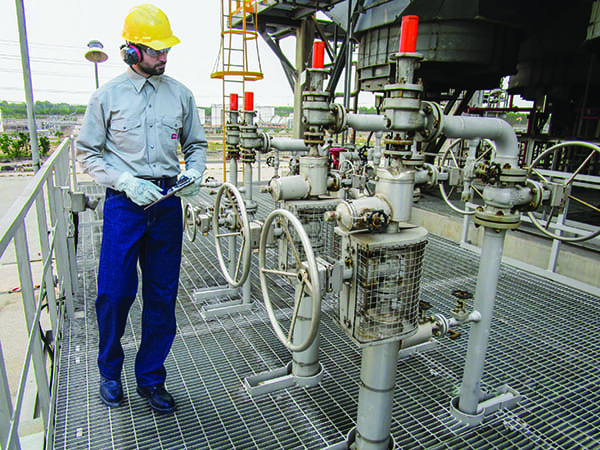You're Never Fully Dressed without Flame-Resistant Clothing
“Personal protective equipment (PPE) is inconvenient and uncomfortable, and this will only take a second. Besides, I’ve done this before, and it’s been fine every time. Will skipping PPE once really hurt?”
These thoughts aren’t uncommon, but they can be incredibly dangerous. According to the Occupational Safety and Health Administration (OSHA), approximately 444 serious injuries and 74 fatalities occur each year among people performing work involving electric power generation, transmission, and distribution. However, wearing the proper PPE, such as arc-rated/flame-resistant (FR) clothing (Figure 1), can go a long way toward improving safety.
Lesson Learned
A power generation plant worker named Brian experienced the difference FR clothing can make firsthand. Brian was working on a 480-V motor control center bucket and his screwdriver slipped, ultimately causing an arc flash. He was not wearing gloves, and although he was wearing an arc-rated shirt, the sleeves were rolled up. When the arc flash occurred, Brian suffered burn injuries to the uncovered parts of his hands and arms, but the areas of his arms that were protected by the shirt remained uninjured.
As a result of the accident, Brian was hospitalized for three days and out of work for three months. He now shares his story with other electrical workers to spread the message that accidents can happen to anyone and to emphasize the importance of wearing the proper PPE.
Regulations and Standards Safeguard Workers
A variety of standards require the use of protective clothing during electrical work. For instance, OSHA 1910.132 requires employers to assess the workplace for hazards and ensure each affected employee wears the appropriate PPE. OSHA 1910.269 provides additional regulations that apply to those operating and maintaining electric power generation, transmission, and distribution lines and equipment. It requires employers to ensure that employees who may be exposed to flames or electric arcs do not wear clothing that could increase the extent of injury. It goes on to state the employer shall ensure that the outer layer of clothing worn by an employee, with some exceptions, is flame resistant under various conditions.
In addition to those OSHA rules, the National Electrical Safety Code and the National Fire Protection Association (NFPA) 70E: Standard for Electrical Safety in the Workplace provide guidance on the specific types of PPE and arc ratings that are necessary for various environments and arc-flash energy exposure levels. The NFPA 70E standard also outlines four PPE categories based on the circumstances and level of protection needed. These PPE requirements take into account the task being performed as well as the condition and type of equipment being used (Figure 2). Meanwhile, NFPA 2112 specifies the minimum performance requirements for flame-resistant fabrics and components, as well as the garment design requirements for protective apparel used in environments with a risk of flash fire.
 |
| 2. Style and safety. Following requirements prescribed in various standards and regulations helps keep workers safe and can save companies money. Courtesy: Workrite Uniform Co. |
When electrical workers choose to forgo FR clothing, it is not only dangerous, but also potentially costly for their workplaces. That is because OSHA fines, general liability costs, lost productivity, workers’ compensation, reputational damage, and other losses a burn injury inflicts, can cost companies millions of dollars.
Choosing the Right Flame-Resistant Clothing
While safe work practices should always be considered the first line of defense, FR clothing can help reduce burn injuries by providing some insulation against heat, and either self-extinguishing or resisting ignition when exposed to flame or electric arc. However, despite these benefits, FR clothing is not always worn compliantly.
There are a variety of reasons workers may choose not to wear FR clothing or wear it incorrectly, such as rolling up the sleeves of an FR shirt. These reasons range from not understanding the importance of PPE to discomfort or disliking the appearance of the clothing. Fortunately, if a person knows what to look for, it is possible to find FR clothing that addresses many of the most common complaints.
For instance, a variety of recent innovations in FR fabrics and manufacturing techniques are making FR apparel more comfortable than ever. For the greatest possible comfort, fabrics that are lightweight (while still offering the appropriate level of protection), breathable, and built for improved moisture management should be chosen.
In addition to choosing comfortable fabrics, workers should look for garment styles that provide a good fit and support job performance (Figure 3). For instance, action backs on coveralls offer more ease of movement, and extra-long shirttails can help ensure shirts stay tucked in during tasks that involve reaching and bending. Additionally, adjustable cuffs can prevent loose sleeves from getting in the way of work or compromising safety. When it comes to pants, workers should look for options with ample storage space in the pockets and leg cuts that are wide enough to fit easily over work boots.
 |
| 3. Sharp-dressed man. Long-sleeved shirts and leather gloves are appropriate safety gear throughout power plant environments. Courtesy: Workrite Uniform Co. |
While the aforementioned features help improve comfort and functionality across the board, it is also important to keep individual differences in mind and select FR clothing that provides the best fit possible for each individual. For instance, certain FR clothing manufacturers now offer workwear designed specifically to provide a more comfortable fit for women. The styles include shirts with vertical darts and contoured seams, as well as pants with a lower rise and improved fit through the seat, waist, and thighs.
Regardless of gender, FR clothing should not be too baggy or too tight, and wearers should be able to easily bend down and reach their arms out. In addition, shirt sleeves and pant legs that are too long can lead to injuries from tripping or excess fabric getting caught on something. If stock sizes do not provide the proper fit, find an FR clothing manufacturer that can work with you to develop custom garments.
Along with improved comfort and functionality, many FR clothing manufacturers have also developed new styles that are designed to imitate off-the-job favorites. For instance, in recent years, significant strides have been made in the area of FR denim. A variety of FR denim options are now available, offering the look and feel workers have always appreciated about a good pair of jeans—without sacrificing safety. Beyond these advances in FR denim, FR clothing manufacturers are continuously creating a variety of other new shirt, pant, and outerwear styles to bring current apparel trends and preferences to the FR workwear market.
If workers like the way their FR clothing looks, fits, and feels, they are more likely to wear it consistently and correctly. And since PPE is the last line of defense against painful, potentially costly injuries—and can even be the difference between life and death—it is worth investing in options that deliver the protection workers need along with the comfort, functionality, and style they want.
—Mark Saner is FR technical manager for Workrite Uniform Co. (www.workrite.com).
